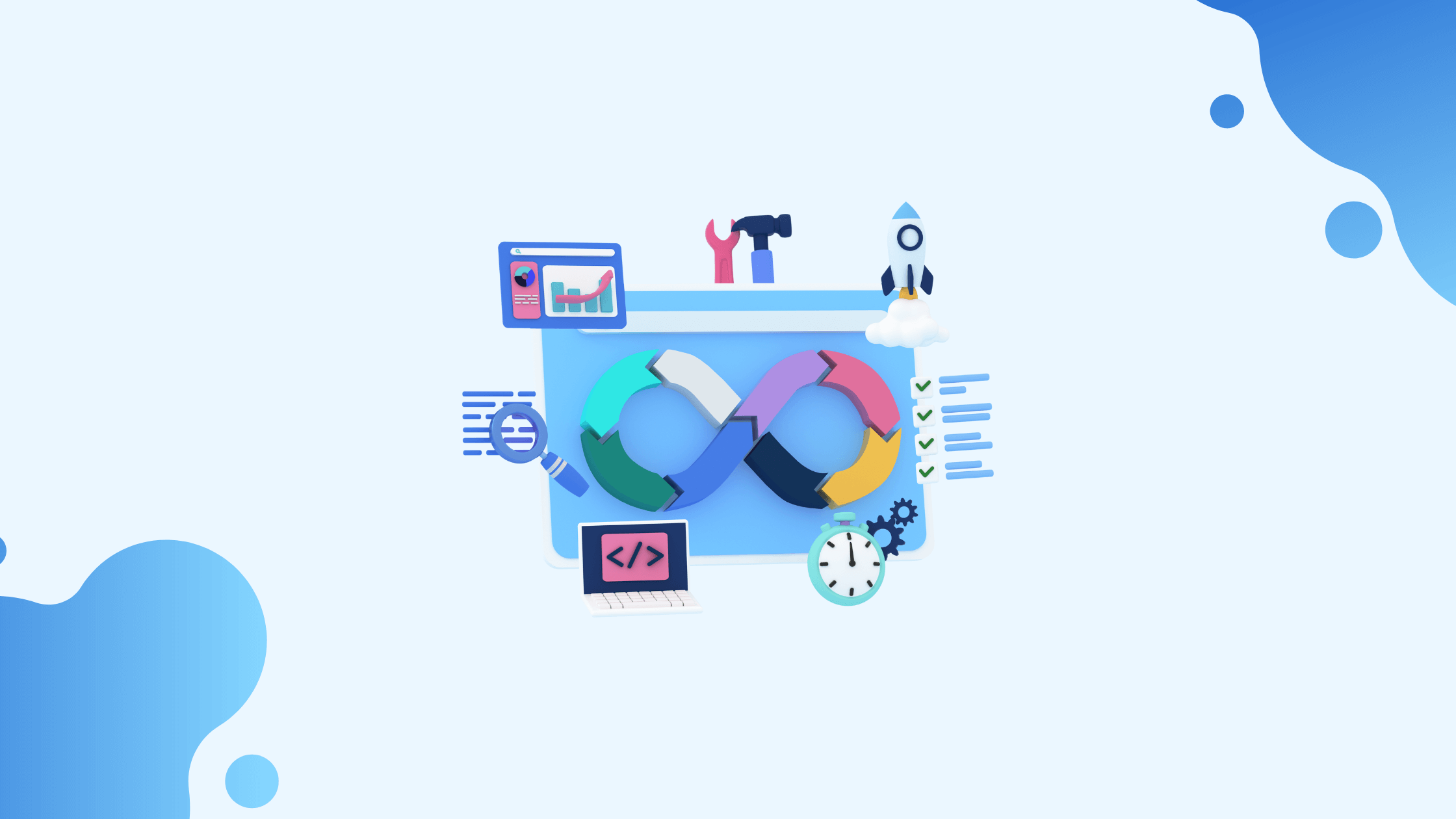This article is based on our hands-on experience architecting and building CI-CD pipelines for several hundreds of projects in the last 3 to 4 years. We have been helping a diverse set of customers across different technology stacks. Every DevOps Leader starts with a basic question - How to implement CI-CD successfully in our company?
This article is not a Step-by-Step Guide to implementing CI-CD in a software pipeline. Instead, it is an overview of the key principles and leadership strategies to implement CI-CD pipelines successfully addressing the needs of your organization, focusing majorly on teams that are starting from scratch.
CI-CD for Leaders
CI stands for Continuous Integration. It involves merging code contributions of various developers into a shared repository like GitHub or GitLab and running automated builds and tests on them, multiple times in a day.
CD stands for Continuous Delivery or Continuous Deployment. Based on the implementation, they both are slightly different. However, they generally refer to the deployment and delivery stages of a CI-CD pipeline. It is primarily the process of deploying the new code to production.

Implement CI-CD pipelines successfully to scale up your businesses seamlessly with measurable growth metrics. Let's take Continuous Testing as an example:
CI-CD can drastically reduce the time spent to test new features before they roll out to customers. By running automated tests, developers can get feedback on their features faster. To improve code quality and reduce bugs on production, run continuous automated tests on every commit, instead of running tests once at the end of software delivery.
With CI-CD, you can minimize the Software Feedback loops drastically. Feature development, enhancements, and fixes will speed up. It also reduces the time to deploy new features for the customers. If you implement CD in the right way, new features can be deployed in just a few minutes after development.
All of this looks like great WINs for IT and Business growth. The only prerequisite to these benefits is to set up the CI-CD system effectively and regularly iterating as per the changing requirements of the business.
Key Principles to implement CI-CD pipeline successfully
1. Adopt Simplicity, Flexibility, and Repeatability
Generally, to implement CI-CD Automation successfully, teams transition from processes that are manual, slow, and time-consuming to automated, fast, and rapid. Some companies can end up going from 3 or 4 releases per year, to 1 or more per week or even per day.
When starting up your first CI-CD pipeline, always stick to the essentials based on your business requirements and immediate needs. Avoid too much overhead in terms of implementation, operations, and optimization, because it may eat up the benefits altogether.
Avoid an extensive set of tools, and hiring, because at this point you may not be sure of what you exactly need. You can add different commercial products if needed later. You can start by outsourcing to a DevOps as a Service company, that understands your requirements and delivers the results in a more cost-effective and timely manner.
Remember, in the beginning, the goal is to create an automated process that takes code contributions from your Source-code Repository, runs builds, tests, and deployments. Updates to the right people are to be sent as the pipeline's progress.
The long-term strategy should be based on Simplicity. Develop your pipelines incrementally, beginning with CI, and gradually scaling up to CD. Low impact jobs like Unit tests, Code Quality analysis, and Automated builds are a good start.
Repeatability is an essential principle for a successful CI-CD pipeline. As automation is built into CI-CD, it is important to allow the jobs in the CI-CD pipeline to be re-executed, if required. So, if a bug is fixed, the pipeline can be re-run easily by the developers themselves, without any extra effort.
Avoid rigidity and structural limitations in the pipeline, due to lack of foresight or experience. Flexibility is a key component, especially when you look at CI-CD as a long-term strategy for business growth.
For example, enabling Concurrent Builds and Deployments. If multiple developers are building features at the same time, nobody should be waiting for other pipelines to succeed. Structure things to effectively allow for the possibility of concurrency. If a feature successfully passes all the checks and tests, it should go live!
2. Building blocks of a successful CI-CD pipeline
The notion of a successful CI-CD pipeline is quite subjective and differs from team to team. You must focus on the fundamentals, as the actual process to implement the CI-CD pipeline successfully is different for every organization.
The basic building blocks as explained in the CI-CD for Leaders section are:
- Continuous Integration: Merge, Build, and run automated tests on builds.
- Continuous Testing: Testing early and testing often at every stage of a CI-CD pipeline.
- Continuous Delivery: Deploy code changes to the target environment with manual approval.
- Continuous Deployment: Deploy code changes to the target environment without any manual approval.
- Continuous Monitoring: Process of monitoring the health, performance, and reliability of your application and infrastructure.
Starting with CI, work towards a high degree of automation, automating delivery and deployment up to Continuous Monitoring. At some point, you have to map all the CI-CD building blocks with several tools. There are an extensive set of tools, available in both open-source and commercial SAAS categories. But, remember Simplicity is a key principle. Too many tools can be cumbersome.
DevOps as a Service - VegaOps tightly integrates powerful open-source DevOps tools like GitLab, SonarQube, Docker, Ansible, ZAP, and many others, translating all the components of a successful CI-CD pipeline for its customers, with a 24/7 Human Service to help companies implement better quality CI-CD processes.
Let's discuss an example, a CI-CD pipeline for a Java Web project can include open-source tools like Nexus as a repository manager, GitLab as a Source-code repository, and CI platform, and Kubernetes for CD.
So, the process would be like, Developers commit their code changes to GitLab, which triggers a build of a Docker image by the CI. Push the Docker image to the Container Registry and use it for automating testing and staging deployments. If all the checks and tests pass successfully, a deployment manifest is sent to the Kubernetes cluster. Kubernetes will in turn pull the latest images and run them as containers, completing the Continuous Delivery cycle of the application.
3. Effective team building for CI-CD
When starting with CI-CD, always pick the right team that can succeed. A high-performing team that is not much afraid of change is always a good choice.
Begin with a small project which has a lesser impact, that you can isolate from other projects as much as possible. You can also start with part of a project, like just the front-end or an even particular microservice. As you gain confidence, you can integrate other components as well. This allows you to be more aggressive and flexible in choosing your approach.
A complex, monolithic application is challenging to fit into DevOps. Similarly, a monolithic culture is difficult to adapt to the Agile mindset of DevOps.
The strategy of starting with CI and low-impact stages like build and Unit tests is advisable if you are starting up from scratch. After you implement CI successfully, with acceptable code coverage, you can begin incorporating the CD stages for deployments into the delivery pipeline.
Also, prioritize Automated Testing, early in the CI-CD pipeline. It will have compounding benefits, as high-quality tests foster buy-in, especially in organizations that might be culturally reluctant to do too much automation.
Continuous Testing improves confidence in your newly automated delivery process. All the project stakeholders can validate the CI-CD pipelines, as and when required, to share continuous feedback. Everyone can check if the pipeline is running properly, passing all the checks and tests which were manual earlier.
Continuous Feedback is important when CI-CD Automation is new and teams are adapting to take their hands off manual operational tasks.
Conclusion
CI-CD can help Agile teams scale up, by implementing discipline, efficiency, and quality control in the Software Development Lifecycle. It often streamlines development cycles and deployments, improving delivery speed and user experiences.
To implement CI-CD successfully in the early stages, focus on Simplicity, Repeatability, and Flexibility. Start with open-source first, and gradually scale up to commercial SaaS products if required. Leverage Automated Testing in the CI/CD pipeline, to boost confidence in the teams. Allow teams to cross-validate and reiterate with shorter feedback loops and strive towards Continuous Improvement.


